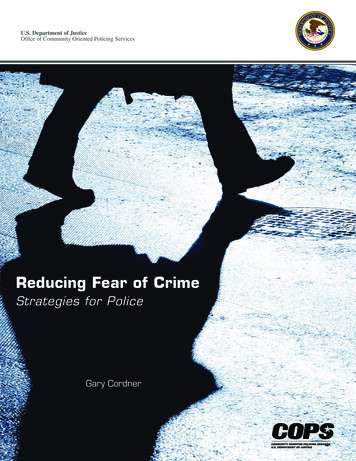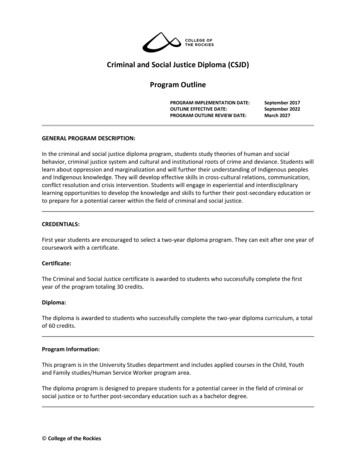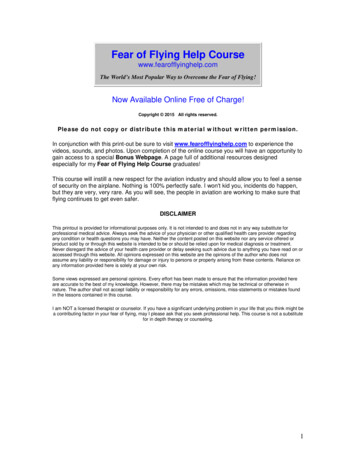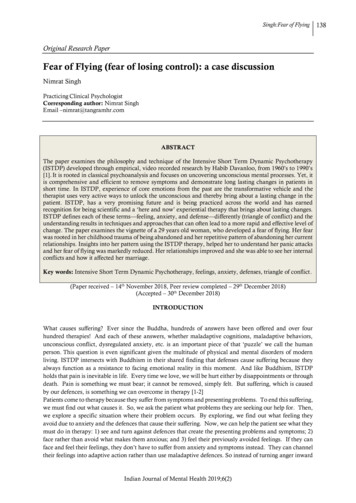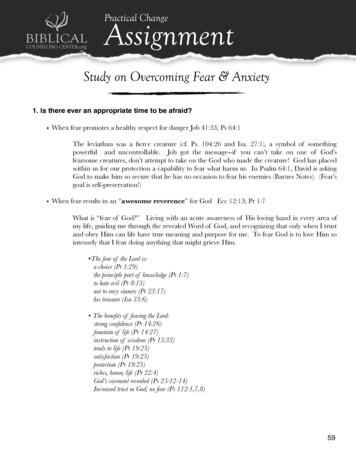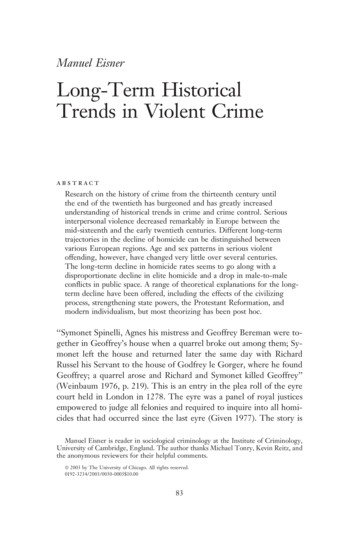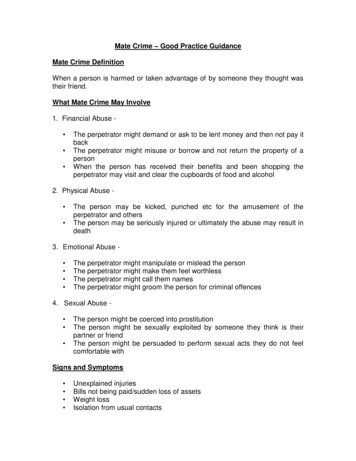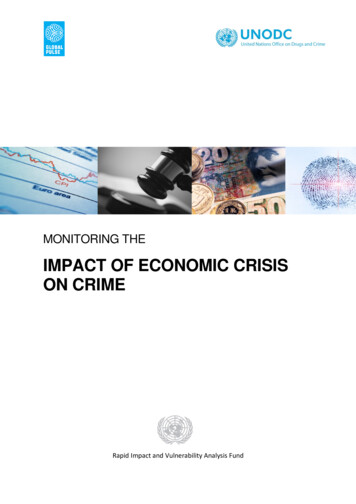
Transcription
CRIME RATES AND FEAR OF CRIMERegional Crime Rates and Fear of Crime —WISIND FindingsBy Mathias Bug, Martin Kroh and Kristina MeierMany people are afraid of falling prey to crime. The present report investigates the extent to which this fear is in line withthe actual regional crime rates. This analysis is based on datafrom a comprehensive database on the fear of crime, combinedwith police crime statistics (specifically, adjusted crime statisticswhich factor in the “dark figure” of unreported crime). Noevidence was found to support the (occasionally voiced) contention that the fear of falling prey to crime is irrational in manycases and not representative of the actual level of safety withina given region. In fact, our data shows a clear statistical correlation between regional crime rates and the fear of crime, bothof which are more pronounced in the north of Germany thanin the south, for instance. The inclusion of cybercrime in crime statistics, however, has meant that the former, higher crimerates and greater fear of crime often recorded in urban areas as opposed to rural regions are no longer as pronounced.The1 fear of becoming the victim of a crime is a widelyknown phenomenon, which, as psychological studiesshow, will often impair the quality of life of the personaffected.2 The fear of crime and perceived or subjectivesafety, however, are occasionally discussed in connection with the irrationality of diffuse fears, media hysteria, or general social insecurity. In fact, studies demonstrate that certain groups — different age groups, for example — miscalculate the probability of their falling preyto crime.3 Similar presumptions are made regarding regional differences: the fear of crime is believed to be higheven in regions where in fact there is very little crime.When statistical data on regional crime rates and fear ofcrime are compiled, two important questions arise: first,what types of crime are to be included and, second, whatis the relative weighting between the different crime categories, the latter occasionally being referred to as theseverity of the offense. In regional crime statistics, pick1 The report was compiled as part of the research project A System ofEconomic Indicators to Measure Security and Security Provision in Germany(WISIND), which is financed by the German Ministry for Education andResearch as part of the Social Dimensions of Security Research fundingprogram. The idea behind the WISIND project and the generation ofWISIND-specific data was jointly developed by Johannes Rieckmann, Eric vanUm, and Nina Wald. The authors would also like to thank Enrique Fernandez,Martina Kraus, Jan-Lucas Schanze, and Bartosz Walenda for their assistancethroughout this process. The present report is based on DIW Economic Bulletin3/2015, in which the different methods used here are described in detail usinga newly-generated crime indicator for the years 2010–2013. See M. Bug and K.Meier, “How to Obtain a More Accurate Picture of Crime Risk through CrimeStatistics — Proposals and Methods,” DIW Economic Bulletin 3 (2015) http://www.diw.de/documents/publikationen/73/diw 01.c.494746.de/diw econbull 2015-03-1.pdf, accessed on February 19, 2015.2 U. Dörmann and M. Remmers, “Sicherheitsgefühl und Kriminalitätsbewertung,” in BKA Polizei Forschung, vol. 1 (2000): 1–2. F. DuBow, E. McCabe, andG. Kaplan, “Reactions to Crime: A Critical Review of the Literature,”unpublished report (Center for Urban Affairs, Northwestern University,1979):93–99 based on J. Garofalo, “The Fear of Crime: Causes and Consequences,”Journal of Criminal Law and Criminology, vol. 72, issue 2 summer, article 20(1981): 852 f.3 D. Ziegleder, D. Kudlacek, and T. Fischer, “Zur Wahrnehmung undDefinition von Sicherheit durch die Bevölkerung. Erkenntnisse und Konsequenzen aus der kriminologisch-sozialwissenschaftlichen Forschung,” Sicherheit,Forschungsforum Öffentliche Sicherheit papers (Freie Universität Berlin, 2012):25, sr v v/sr 5.pdf,accessed on November 11, 2014.DIW Economic Bulletin 12.2015167
Crime rates and fear of crimepocketing, which is a minor offense, is ascribed less significance than robbery, for instance.The present report is limited to forms of crime thathave a direct impact on individuals and consequentlyexcludes white-collar crimes, for example. While theassignment of specific weighting to individual offenses is instrumental in evaluating overall crime rates andthe fear of crime, there are many weighting methodswhich are equally legitimate. We have therefore chosento use four different approaches, the results of whichwill then be compared. 4Objective Crime Statistics and SubjectiveFear of CrimeHere, objective regional crime is defined as offensescommitted, the victims being citizens of the said region. The following offenses are included in the objective crime statistics: burglary, theft, cybercrime, criminal threat, bodily harm, homicide, and politically motivated crime. These offenses were specifically selected toenable the indicator to be used to measure crime that directly affects the individual. The study is based on datafrom the German police crime statistics (polizei licheKriminalstatistik, PKS) and, to include politically motivated crime, the Annual Reports of the intelligence servicesof the German Länder. Both databases contain recordedcrime only, meaning they do not paint a fully accuratepicture of the actual crimes committed. To ensure thatthe “dark figure” of crime (i. e., the number of offensesthat are not officially reported) is also factored in, the figures for the individual offenses taken from the PKS andthe protection of the constitution reports are adjusted byan offense-specific unreported crime factor (see Box 1).private expenditure on security5 and data from social networks were employed.6 Although each individual meansof evaluating the fear of crime has its own inherent problems — for example, the case numbers in population surveys are often insufficient to allow us to draw meaningfulregional conclusions, and information taken from socialnetworks reflects the fear of crime for a specific population group only — the sheer variety of the data sources isintended to offset the individual shortcomings.Discussions in relevant research communities have longsince centered on survey-based analysis of the fear ofcrime.7 Owing to the abstract nature of fear, however,no consensus has been reached to date on how to evaluate this fear in surveys. One common question is that ofthe individual’s feeling of safety during a late-night walkthrough one’s neighborhood. (The approximate wording is as follows: “How safe do you feel when walkingthrough your neighborhood alone at night?”) Despite thecriticism leveled at this indicator for the fear of crime,8 itcontinues to be used for this purpose, not least becauseit allows different studies to be easily compared. Sinceit is incorporated into the Germany-wide WISIND survey, this question is also included in the present study.Another data source used is the Socio-Economic Panel(SOEP) study, a large panel study of households in Germany, which also includes a general question on the fearof crime (“How worried are you about the following areas?: [ ] The trends observed in crime in Germany.” 9).105 C. Gummer et al., „BIGS-StudieSicherheitswirtschaft 2012“ (2013). Y.Gruchmann, et al., „BIGS-Studie Sicherheitswirtschaft 2013“ (2014).6 in this economic bulletin See J. Rieckmann and J.-L. Schanze, “Perceptionsof Personal Safety in Social Media and Search Engines – a Realistic Reflectionof Actual Crime Rates” (2015).7The subjective fear of crime refers to the fear among agiven regional population of becoming the victim of acriminal offense. To enable objective crime statistics tobe reliably compared with the subjective fear of crime,the offenses selected to assess the fear of crime largelyconform to the aforementioned forms of crime used inobjective crime statistics.Unlike objective crime rates, which are often based on thePKS, no reliable database is available for the subjective fearof crime. However, to ensure that findings on the fear ofcrime are both generalizable and cover as broad an empirical basis as possible, existing survey data is used, aswell as a study of our own which was conducted as part ofthe WISIND project and examines victimization and thefear of crime among the population; in addition, data on4 For a more detailed explanation of the chosen weighting methods, see Bugand Meier, “How to Obtain a More Accurate Picture of Crime through CrimeStatistics — Proposals and Methods,” DIW Economic Bulletin, no. 3 (2015).168For an overview see Ziegleder, Kudlacek, and Fischer, “Zur Wahrnehmung.”8 A discussion of relevant literature can be found in M. Bug and E. van Um,“Herausforderungen bei der Messung von Kriminalitätsfurcht,” DIW Roundup,no 49 (2015). www.diw.de/documents/publikationen/73/diw 01.c.491381.de/diw roundup 49 de.pdf, accessed on February 19, 2015. Also see M.Noack, “Probleme bei der Reliabilitäts- und Stabilitätseinschätzung fürallgemeine Kriminalitätsfurchtindikatoren,” in “Empirische Forschung überKriminalität,” eds. S. Eifler and D. Pollich (Wiesbaden: Springer VS, 2015):249–274. For an international discussion, see K. F. Ferraro and R. L. LaGrange,“The measurement of fear of crime,” Sociological Inquiry 57 (1987): 70–101.9 TNS Infratest Sozialforschung, “2014. SOEP 2014 – Erhebungsinstrumente2014 (Welle 31) des sozio-oekonomischen Panels: Haushaltsfragebogen,Altstichproben,” SOEP Survey Papers 236, series A (Berlin: DIW/SOEP, 2014).Valid answers follow a three-point scale from very concerned, somewhatconcerned, to not concerned at all.10 Parallel to the usage of the standard indicator, many long term orientedstudies are based on the SOEP questionnaire: C. Krekel and M. L. Poprawe, “TheEffect of Local Crime on Well-Being: Evidence for Germany,” SOEP Papers 678(Berlin: DIW/SOEP, 2014). J. Dittmann, “Entwicklung der Kriminalitätseinstellungen in Deutschland – eine Zeitreihenanalyse anhand allgemeinerBevölkerungsumfragen,” DIW Discussion Papers, no. 468 (2005). http://www.diw.de/sixcms/detail.php?id diw 02.c.230702.de, accessed on November 23,2014. J. Dittmann, “Wahrnehmung der Kriminalität im Zeitverlauf,”(Bundeszentrale für politische Bildung, 2013a): hrnehmung-der-kriminalitaet-im-zeitverlauf, accessed onNovember 24, 2014.DIW Economic Bulletin 12.2015
Crime rates and fear of crimeBox 1Objective Crime RatesThe offenses under consideration are broken down as followsusing PKS (police crime statistics) codes:Theft (PKS code ****00 excluding 440*00), burglary (PKScode 435*00 and 436*00), assault (PKS code 222000 and224000), verbal threats or similar (PKS code 232300,673000, 232200, and 232400), cybercrime (PKS code980100 via the Internet), and murder and manslaughter (PKScode 892500).1 The findings presented in the present articlethe issue was recognized and resolved by anti-virus software.The estimated number of unknown cases of cyber crime ispertinent since some of these damages are borne directly bybanks, insurance companies, and other service providers orthe low level of damages incurred reduce the willingness ofvictims to come forward. The generally perceived low clearance rates for these offenses and the lack of knowledge aboutcybercrime reporting procedures is likely to reduce incentivesto report these crimes to the police.are based on the frequency of the offenses. These arecalculated according to the formula for each region:Absolute no. of offenses 100,000No. of inhabitantsSince police statistics only include reported crimes, the problem of unreported crimes can only be taken into account bycalculating offense-specific correction factors. To estimate theshare of crimes that went unreported, a nationwide victimization survey was conducted. 2The table shows calculated correction factors based on offense-specific estimates of figures for unreported crimes (averaged between 2012 and 2013). While the correction of thesefigures for property crimes and assault is comparatively low,there is a noticeable factor for unreported crimes relating toburglary. What is most striking are the figures for unreportedcybercrimes. Only those cases that cause actual damage areconsidered, e. g., from a virus attack, and not in cases where1Bundeskriminalamt, “Polizeikriminalstatistik” (2013).2See Bug and Meier, “Crime Statistics.”Besides these general questions on individuals’ feelingof safety and their concerns about crime and the development of crime on the whole, the WISIND survey alsoexamines risk perception with regard to crimes againstproperty, physical violence, and cybercrime (see Box 2).To cover the different dimensions of the fear of crime asfar as possible, the analysis of the region-specific fear ofcrime presented here is not only based on survey findings but also includes crime-related behavioral patternswhich can be seen as an indirect expression of the fearof crime. Thus, the conative dimension of the fear ofcrime — i. e., protective or avoidance behavior — can befactored into the indicator. This behavior includes private expenditure on security equipment, which is examined in a survey of German security firms conductedDIW Economic Bulletin 12.2015TableMeans of Dark field Estimates for 2012 and 2013MeanMurder and Manslaughter1Standard dily Harm4.0470.72128.9110.339247.1511.848ThreatCrime via the Internet1 Calculated on base of a Germany wide study of autopsy mistakes( Brinkmann 1997).Source: Bundeskriminalamt (2012, 2013): Polizeiliche Kriminalstatistik.Bug, M.; Kroh, M.; Meier, K.; Rieckmann, J.; van Um, E., Wald, N. (2015):WISIND-data DIW Berlin 2015One officially known case of bodily harm represents four actualcases of bodily harm (3 out of 4 cases are not reported to thepolice).by the Brandenburg Institute for Society and Security(Brandenburgisches Institut für Gesellschaft und Sicherheit,BIGS) annually since 2012.11Finally, user-generated communication with reference tocrime in social networks was used for the indicator — anew and innovative approach. Here, over a period of fourmonths, an extensive list of search engine keywordswas used to pinpoint relevant posts, which were thenassigned to the specified location data; these indicatordata were then factored into the analysis of regional fear11 C. Gummer et al., „BIGS-StudieSicherheitswirtschaft 2012“ (2014). Y.Gruchmann, et al., „BIGS-Studie Sicherheitswirtschaft 2013“ (2014).169
Crime rates and fear of crimeBox 2Survey Data on Subjective Fear of Crime (WISIND Survey)As part of the WISIND project, a representative telephonesurvey was conducted from July through September 2014 byTNS Emnid in which 12,094 people in Germany were askedabout their experiences and perception of crime. One-fifth ofrespondents were surveyed on cell phones. The nationwidesample was drawn proportional to the regional populationand includes at least 15 respondents per city or regionaldistrict. The following questions are relevant indicators ofsubjective fear of crime, or risk perceptions to be more precise:Questions on the various types of crime:1B.1: “If you think back over the last 12 months, how worriedwere you that someone would steal something from you—whether you were at home or elsewhere—without you beingthreatened with violence or violence being used against you?”1 Possible replies follow the logic of a four, point scale and are thefollowing: “very probable/probable/improbable/very improbable” or“very worried/somewhat worried/not really worried/not worried at all”.of crime.12 In particular, public content such as Facebookand Twitter were used, as were various online forums.Weighting Criminal OffensesTo investigate crime rates and the fear of crime in general, the simplest method is to add up the relative frequencies of individual offenses in a given region by offense category. Accordingly, the fear of crime can becalculated as the sum of the relative frequency of expressions of concern among the population across theindividual offense categories. One possible criticism ofthis method is that it does not take into account the relative severity of the offense, meaning a robbery is regarded in the same light as pickpocketing. To evaluatethe significance weighting of individual offenses, threealternative weighting methods were used in addition toequal weighting.B.2: “How likely do you think it is that something will be stolen from you in the next 12 months—whether you are at homeor elsewhere—without you being threatened with violence orviolence being used against you?”B.8: “If you think back over the last 12 months, how concerned were you that, for whatever reason, you would be thevictim of assault?”B.9: “How likely do you think it is that you will be the victim ofassault in the next 12 months?”B.17: “How concerned were you in the last 12 months that youwould be the victim of cybercrime?”B.18: “How likely do you think it is that you will be the victimof cybercrime in the next 12 months?”The analyses below use the respective averages of offensespecific questions about concerns and probability to evaluaterisk perception.The personal perception of the severity of differentcriminal offenses was investigated using an online survey among 2,53213 respondents asked to rank the different offense categories successively by severity. The result was a weighting scale which was originally basedon paired comparisons of rank ordered offense categories. The same survey was conducted among 207 experts (predominantly from the field of security researchwith a small number from the security business) as well.In addition to these opinion-based methods, the significance weighted values for individual offenses were alsoestimated using item response theory.14 The basic ideabehind this statistical method is that a factor which isnot observed directly (in our case, regional crime ratesor the regional fear of crime) is expressed in the indicators observed (in our case, the actual crimes committedor the expression of fear per offense category). Here,13 To avoid systematic deviations between the survey data and thepopulation, the sample also included respondents who do not use the Internet.For more details, see Bug and Meier, “Crime Statistics.”12 For more details, see Rieckmann and Schanze, “Perceptions of PersonalSafety in Social Media and Search Engines – a Realistic Reflection of ActualCrime Rates” (2015) in this issue of DIW Economic Bulletin.17014 F. M. Lord, M. R. Novick, and A. Birnbaum, Statistical theories of mental testscores (Reading, MA: Addison-Wesley, 1968); G. Rasch, Probabilistic models forsome intelligence and attainment tests, Danish Institute for EducationalResearch, Copenhagen, expanded edition with foreword and afterword by B. D.Wright (University of Chicago Press, 1960/1980). P. F. Lazarsfeld and N. W.Henry, Latent Structure Analysis (Boston: Houghton Mifflin, 1968).DIW Economic Bulletin 12.2015
Crime rates and fear of crimethe relative frequency of the relevant offense is takeninto account, as are statistical relationships between offenses. If this is found to be particularly strong, — if,for instance, a certain offense is committed particularly often in an area where other crimes can also befound — this offense is deemed to be particularly effective (having good “forecast quality”) as an indicator of general crime and fear of crime. What is knownas the relevance parameter (shown in Table 1) denotesthis forecast quality. Provided the relevant data areavailable, the weighting method used for the objectivecrime rate indicator is the same as that for the subjective fear of crime.15Table 1 shows the significance weighted values resulting from the methods used to weight offenses. The results are relatively uniform and intuitive. Physical violence is regarded as being more severe than crimesagainst property, while verbal threats and suchlike wereperceived least serious. An interesting finding was thehigh weighting assigned to politically motivated crimes,which was the same across all the weighting methodsused and would seem to imply that the political systemin Germany is highly respected and valued.The statistical correlations found between the individual offenses — as seen in the item response theory results — suggest that murder or manslaughter is not onlya very rare offense (frequency parameter) but also displays a weak association to the frequency of other offenses (low relevance parameter), i. e., in a regional comparison, murder is a rather incidental occurrence. By wayof contrast, threatening behavior, theft, and cybercrimeare offenses that systematically occur in areas which areparticularly strongly affected by crime, which is whysuch offenses feature more often in determining general crime rates in a given region.By analogy, Table 2 shows the weighting of criminaloffenses used to assess the subjective fear of crime. Asexplained above, the significance weighted values taken from the objective indicator are averaged accordingto broader offense categories. For sub-indicators whichcannot be allocated to a specific offense, the averageis used across all the weighted values. Table 2 also depicts the relevance parameters of the individual offens15 Owing to the aforementioned, broader crime categories crimes againstproperty, physical violence, and cybercrime, different relative degrees of severityare approximated as the relevant averages (for crimes against property, forinstance, the weighting is calculated as follows: (Weight Burglary Weight Theft)/2. Please note that, when calculating the weighting of thebroad crime categories, the weighting of other offenses which are included inthe online survey, but which were not used for the actual crime indicator is alsofactored in. For example, the opinion-based weight for physical violence alsocontains a weight for rape. Due to database problems (in particular areaswhere police crime statistics show a very high dark figure), this offense is notpart of the objective threat indicator.DIW Economic Bulletin 12.2015Table 1Crime WeightsPopulationExpertsMurder and Manslaughter0.90550.9585IRT (1/frequency) IRT (Relevance)1(fix)0.000079Politically motivated crime0.10120.10670.0530.035Bodily Harm0.04760.06610.0011(fix)Internet 0.01930.00026.654Source: Bundeskriminalamt (2013): Polizeiliche Kriminalstatistik; Bug, M.; Kroh, M.; Meier, K.; Rieckmann, J.;van Um, E., Wald, N. (2015): WISIND-data files: Weighting; Calculations by DIW Berlin. DIW Berlin 2015Security experts as well as the general population give crime via the internet a weight thatis worse than burglary.Table 2Weighting of fear regarding different crime categoriesAssaultPopulationExperts0.2470.267IRT (Relevance)risk assault1.46Manslaughter /Assault0.922Property crime0.0150.017risk property1.127Burglary / Theft0.896Assault /Property Crime (standard indicator)0.1810.195standard indicatorCybercrime1(fix)0.0260.0340.1320.146risk Internet CrimeUnspecific (mean of all crime categories)0.6SOEP (Worries about development of crime)0.118BIGS (Priovate spending on security)0.476Source: Bug, M.; Meier, K.; Kroh, M.; Rieckmann, J.; van Um, E.; Wald, N. (2015): WISIND-Datafiles Crimeweighting/social Networks. Gruchmann, Y.et al. (2014): BIGS-Studie Sicherheitswirtschaft Juni 2014,Gummer, C. et al. (2013): BIGS-Studie Sicherheitswirtschaft Mai 2013. SOEPv30; Calculations by DIW Berlin. DIW Berlin 2015The fear regarding Internet crime and property crime show the lowest weights. This followsthe feasibility of financial compensation of this crime category.es, which display similar results to Table and are to beequally interpreted.1616 Table 2 disregards the parameters for relative frequency (IRT model) peroffense. When using item response theory (IRT) to analyze the regional fear ofcrime, the average regional fear of crime per offense is divided into a maximumof three groups with ascending values. The relevant IRT model for ordinal datadepicts the relative frequency for each of these (max. three) categories peroffense and the inclusion of these parameters would make presenting thesummary of figures in Table 2 unnecessarily complicated.171
Crime rates and fear of crimeFigure 1Regional Crime Indicator 2013 (full version)PKS (with dark-figure adjustment)Population-based WeightingEstimate via IRT (Item Response Theory)PKS (without dark-figure adjustment)Expert-based Weighting10Source: Bundeskriminalamt (2012, 2013): Polizeiliche Kriminalstatistik. Bug, M.; Kroh, M.; Meier, K.; Rieckmann, J.; van Um, E.; Wald, N. (2015): WISIND-data files: Crime Survey/Crime weighting.Calculations by DIW Berlin. DIW Berlin 2015The dark-figure adjustment weakens differences between urban and rural areas. Higher crime rates in the north stay obvious.Regional DifferencesGenerating a reliable description of regional differences in the fear of crime requires a sufficient number ofrespondents per regional unit. Although the WISINDsample has at least 15 respondents from each of the 402administrative districts in Germany, in order to shore upthe robustness of the reported findings, the followingdescription divides the country into 60 regions basedon the 402 urban and rural districts. The objective of172dividing up these areas is to create regional units withat least one million residents. These units are based onstate- and government districts as well as police boundaries (police headquarters).17 In order to allow a directcomparison between subjective fear of crime and ob-17 In some cases, historical/cultural borders were used for regionalizing thefederal states. Some cities were removed from their regions to allow them to beconsidered separately.DIW Economic Bulletin 12.2015
Crime rates and fear of crimejective crime rates, the crime rate is also aggregated inthese regions — in principle, data on individual counties could be reported based on criminal statistics compiled by the police.18 Crime rates and fear of crime areall normalized to the interval [0–1], where 1 representsthe highest crime rates and/or fear of crime.Figure 2Regional Indicator Fear of Crime 2013/14Estimate via IRT (Item Response Theory)Population-based WeightingExpert-based WeightingUnweightedFigure 1 shows the results of the indicator for objectivecrime rates for 2013 at regional level. All approaches tocrime weighting produce comparable results: what isparticularly striking is the distinct north-south divide,with higher crime rates in the north. As expected, themajor cities (except Munich) stand out, as do the conglomerates of the Rhineland and the Ruhr.A comparison of the crime rate maps with and withoutestimated numbers of unknown cases in Figure 1 indicates a stronger regional differentiation due to the adjustment for unreported crime. This adjustment highlights, for example, a higher crime rate in large parts ofBaden-Württemberg, Thuringia, Saxony-Anhalt, andBrandenburg.The different methods of crime weighting lead tothoroughly comparable results — as noted in previousstudies.19 In contrast to equal weighting of crimes, opinion-, expert-, and statistics-based (IRT) weighting particularly in the urban areas of North-Rhine Westphalia and in the region Oldenburg indicate higher crimerates — compared to similar regions. The relatively highcrime rates in Mecklenburg-Western Pomerania usingall forms of weighting can be explained by a disproportionately high volume of cybercrime in these areas in2013. This effect disappears in the alternative calculation of crime indicators without this form of crime(see Box 2).Figure 2 shows the results for the indicator of subjectivefear of crime compared to the objective crime rates. Thefrequently made statement that fear of crime is high inregions where the actual threat is low can only be confirmed in individual cases here (see Figure 3). Examplesof this are predominantly in parts of Swabia, primarilythe counties around Stuttgart. In most regions, how ever,there is a more or less ref lective association betweenrisk perception and measured crime. This correlationis particularly clear in the overall regional distributionshown in Figure 3.One striking discrepancy between fear of crime and actual crime can be observed in Mecklenburg-Western Po18 Although WISIND survey data are included in regional crime ratecalculations to adjust police crime data for the estimated number of unknowncases, this number is uniform throughout Germany.19 Bug and Meier, “Crime Statistics.”DIW Economic Bulletin 12.201510Source: Bug, M.; Kroh, M.; Meier, K.; Rieckmann, J.; van Um, E.; Wald, N. (2015): WISIND-data files: Crimeweighting/Social Networks. Gruchmann, Y.et al. (2014): BIGS-Studie Sicherheitswirtschaft Juni 2014, Gummer, C. et al. (2013): BIGS-Studie Sicherheitswirtschaft Mai 2013. SOEPv30; Calculations by DIW Berlin. DIW Berlin 2015There are slightly higher rates of fear of crime in the north. Between urban and rural areas,no consistent differences are detectable.merania. A closer look at criminal activities there suggests that the relatively high crime estimates for this region are largely driven by Internet crime. This type ofcrime is growing very rapidly in two ways. The development of reported Internet crime reveals high growthrates (although the number of official cases is still relatively low compared to more “well-known” offenses).173
Crime rates and fear of crimeFigure 3Box 3WISIND-Indicator of Crime and Fear of CrimeTaking Account of Cybercrime in Calculatingthe Crime Rate1.0Indicator for Fear of Crime (population weights)Berlin0.9The unreported crime factor of 247 represents a significantintervention in the raw data of the police crime statis-0.8tics — although the offi
G. Kaplan, "Reactions to Crime: A Critical Review of the Literature," unpublished report (Center for Urban Affairs, Northwestern University,1979): 93-99 based on J. Garofalo, "The Fear of Crime: Causes and Consequences," Journal of Criminal Law and Criminology, vol. 72, issue 2 summer, article 20 (1981): 852 f.

